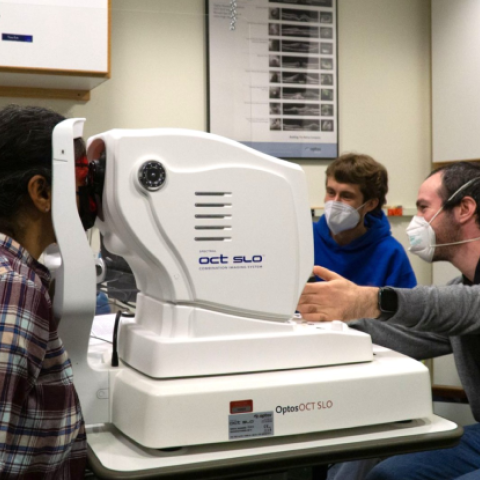
- Principal Investigator:
- Lora Likova
This project is designed to advance the integration of high field fMRI in alert macaque monkeys with "informed" neurophysiology, and to apply it in addressing a long-standing research question regarding the neural processing of stereoscopic 3-D motion. Stereo and motion are usually studied separately, and the cortical regions involved in the binocular perception of motion-in-depth in macaque monkeys are poorly characterized, while those for cyclopean (solely disparity-based) stereomotion perception are unknown. However, in humans, recent studies of the PI of the Smith-Kettlewell node have identified specialized brain regions specifically involved in cyclopean stereomotion processing, including one near the motion complex hMT+, termed the cyclopean stereomotion region.
The project is led by Prof. Paul Gamlin (UAB) and Dr. Lora Likova (Smith-Kettlewell). We have developed techniques for performing fMRI studies at high-field in alert, behaving macaques. Therefore, employing the same visual stimuli as used in humans, we will use fMRI to identify cyclopean stereomotion regions in macaques, and to then characterize neuronal responses within one targeted region. The planned studies are relevant to health, since visual field deficits in stereomotion processing are closely correlated with deficits in vergence eye movements, and the same defect in binocular interaction appears to underlie both abnormal behaviors. Studies of the neural processing of stereomotion in non-human primates will not only provide insights into the cortical areas involved in processing this motion information and in controlling vergence eye movements, but will also potentially aid in the diagnosis and treatment of strabismus and diplopia. Specifically, using fMRI we will examine the cortical areas activated by cyclopean, motion-in-depth stimuli presented with dynamic random-dot stereograms (DRDS). These stimuli will be contrasted with appropriate, fixed-disparity DRDS stimuli. Our preliminary fMRI data from macaques have identified two well-localized foci of activation with these stimuli: one in the superior temporal sulcus (STS) in a location that partially coincides with MSTv, and the other is in the intraparietal sulcus. Next, since this is an exploratory grant of limited duration, we will concentrate our neurophysiological studies on the well-localized focus of activation within the STS. Specifically, using MRI-guided electrode placement in this targeted region, we will search for responsive neurons while the animals view cyclopean, motion-in-depth DRDS stimuli with the only cue to motion-in-depth being the change in disparity over time (CD). Next, using these stimuli, we will determine the receptive field size and location, and the speed tuning and z-axis directional selectivity of the neurons. Then, using RDS stimuli that possess both CD and interocular velocity difference motion-in-depth cues, we will examine neuronal response when both binocular cues to motion-in-depth are present. We will further characterize neuronal responses to stereomotion stimuli with frontoparallel and oblique trajectories, and during vergence eye movements.
HEALTH RELEVANCE Accurate binocular alignment of the eyes on targets at different distances requires precisely coordinated movements of the two eyes, known as vergence eye movements;individuals with deficits in vergence eye movements are often strabismic and report diplopia (double-vision). Visual field deficits in stereomotion processing are closely correlated with deficits in vergence eye movements, and it has been suggested that the same defect in binocular interaction underlies both abnormal behaviors (Regan et al., 1986). Our studies of the neural processing of cyclopean stereomotion in non-human primates will not only provide fundamental insights into the cortical mechanisms involved in processing this motion information and in controlling vergence eye movements, but will also potentially aid in the diagnosis and treatment of strabismus and diplopia.

